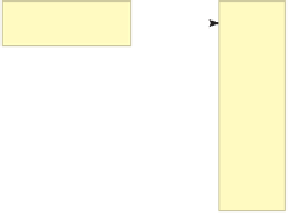Java Reference
In-Depth Information
The variable
words
is an array of references to
String
objects. The
new
operator
in the declaration instantiates the array and reserves space for five
String
refer-
ences. This declaration does not create any
String
objects; it merely creates an
array that holds references to
String
objects. Initially, the array looks like this:
words
—
—
—
—
—
After a few
String
objects are created and put in the array, it might look like this:
words
“friendship”
“loyalty”
“honor”
—
—
The
words
array is an object, and each character string it holds is its own object.
Each object contained in an array has to be instantiated separately.
Keep in mind that
String
objects can be represented as string literals. So the
following declaration creates an array called
verbs
and uses an initializer list to
populate it with several
String
objects, each instantiated using a string literal:
String[] verbs = {"play", "work", "eat", "sleep"};
The program called
GradeRange
shown in Listing 8.5 creates an array of
Grade
objects, then prints them. The
Grade
objects are created using several
new
opera-
tors in the initialization list of the array.
The
Grade
class is shown in Listing 8.6. Each
Grade
object represents a let-
ter grade for a school course and includes a numerical lower bound. The values
for the grade name and lower bound can be set using the
Grade
constructor, or
using appropriate mutator methods. Accessor methods are also defined, as is a
toString
method to return a string representation of the grade. The
toString
method is automatically invoked when the grades are printed in the
main
method.
Let's look at another example. Listing 8.7 shows the
Movies
class, which
contains a
main
method that creates, modifies, and examines a DVD collection.
















Search WWH ::

Custom Search